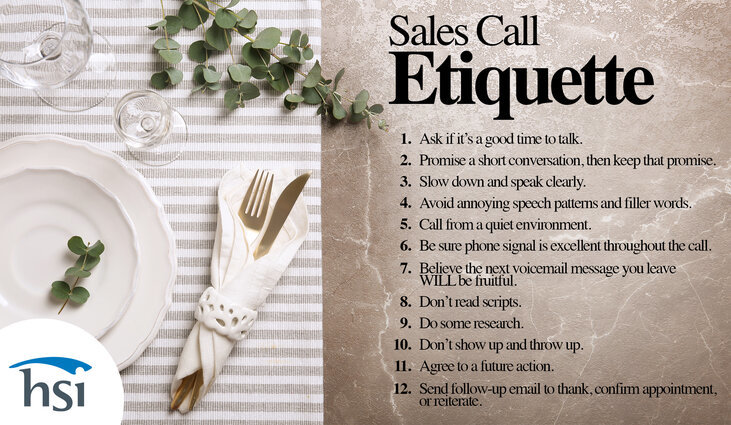12 Phone Etiquette Tips for Sales Calls

When you say the word "etiquette" I worry about which fork to use, keeping my elbows off the table, and drinking with my pinky up. In the world of sales calls, etiquette has a different spin.
Let’s face facts, no one wants to talk to salespeople on the phone. No one. That’s the first obstacle. The salesperson on the phone has a flash of an instant to overcome that obstacle and make a positive impact on a stranger that is yearning to hang up. Adding any additional obstacles to this scenario only diminishes the salesperson’s chance for success. Presenting yourself with the most polished phone etiquette on sales calls will only help.
Here are 12 phone etiquette tips for sales calls:

1. Ask if it’s a good time to talk.
I can’t think of anything much more embarrassing than finally getting a prospect to pick up their phone, having you introduce yourself, beginning to give your best sales pitch, and having the prospect interrupt you to explain that they are in the middle of writing a presentation at the moment and they can’t talk. Sure, you can apologize and promise to call back later, but you’ll have some damage control to perform at that time. That is if you have the courage to try again.
When you’re lucky enough to get a prospect to answer your call, begin the conversation with an introduction and then ask if they have time to talk. “Hi, Marie, this is Ken at HSI. Would you have time for a brief conversation?” If they don’t, ask them to recommend a better time later in the day or week for another call.
2. Promise a short conversation, then keep that promise.
One reason why people hate talking to salespeople is the fear that the “brief conversation” will take up a lot more than a “brief” period of their day. As another alternative for tip #1, after the introduction, ask, “Would you have time for a 30-second conversation?”, or “Do you have 30 seconds for me?” If they agree, then check your watch, set a timer, or severely limit your message to keep YOUR part of the conversation under the promised time limit. Of course, if they want to keep talking, then by all means, keep going, but you should still stop at the promised time limit, and check to see if the prospect wants to continue or set a time for a longer discussion.
3. Slow down and speak clearly.
Every salesperson should be excited to talk about their product. After all, it’s the best product in the marketplace, right? When we talk about something exciting, our speech patterns change. Our voice might get higher and we might talk much faster. Trying to comprehend a fast talker is tough. Sometimes trying to comprehend a fast talker over the phone can be even more difficult. Trying to get a prospect to want to talk to a fast-talking salesperson is impossible. Be aware that you may be talking too fast. Take a breath and speak clearly and more slowly. Be calm and sell on!
4. Avoid annoying speech patterns and filler words.
Do you know if you have any, like, annoying speech patterns or whatever? I mean, some people can, like, really be, um, annoying. Like, um, you know? This tip might require your enlistment of others to use “tough love” and tell you like it is. Ask someone you trust to tell you if your speech patterns or use of filler words (uh, um, like,) can be considered annoying. You might also try recording yourself speaking or leaving a voicemail message. Listen for problems that you were not aware of before that might be chasing prospects away.
5. Call from a quiet environment.
Many of us love dogs. Most of us love babies. No one loves to hear a dog or baby in the background of a sales call. It’s distracting and it’s sometimes considered disrespectful. It makes it obvious that your main focus during that call may not be on the client, but possibly on the noisy little beast in the room. Put yourself in a quiet area, away from distractions. That goes for TVs and music sources as well.
6. Be sure phone signal is excellent throughout the call.
Lots of salespeople are road warriors. The only time they are in the office is one day per week. Otherwise, they are gripping the steering wheel and viewing the world through their windshield. If they are to keep their pipeline filled and their opportunities moving through the pipeline, they have to make their sales calls from the car. This can be tricky on a few levels.
First and foremost, be careful! Use a hands-free phone option to keep from being a distracted driver. Some states require this for good reason. Next, road noise can make conversations difficult. See tip #5. Finally, make sure you have a strong cellular signal before attempting a call. Cellular towers come and go quickly when you’re driving on a highway. If you start a call with a mid-strength signal, there’s a good chance of having a low signal or no signal long before the call is supposed to end. Having a call with a prospect get cut off due to a lost cell signal is almost as embarrassing as the setting in tip #1.
7. Believe the next voicemail message you leave WILL be fruitful.
This is the attitude you need to have and keep when making prospecting sales calls. It doesn’t matter if you just made 100 calls per day for 3 straight days without ever talking to a soul and without anyone ever calling you back. You must believe that this next voicemail you leave WILL be listened to and they WILL call you back. Your message had better be left with enthusiasm and clarity. If you sound bored, beat up, tired, or disinterested in your product, the prospect will have no interest in calling back.
8. Don’t read scripts.
I.have.heard.very.experienced.sales.people.reading.their.voicemail.scripts. It sounds choppy, and the rep sounds uneducated on their product and unprofessional. If a prospect wants to find out more about your product, they want to talk to an expert. Experts don’t read from brochures or prepared scripts. They know their product so well that they can discuss it freely without ever having to recite notes or scripts. It’s OK to have notes or talking points in front of you to refer to during the call. Incorporate those notes or talking points into your adlibbed message. Be an expert.
9. Do some research.
Know some basic things about the prospect you are calling. What kind of business are they? Do you have any current clients in their industry or geographic area? Is there anything interesting in the news about them? Who are their competitors? This information can be gathered easily and quickly before you call. Use that information during your conversation to build rapport, or incorporate the information into your voicemail message to show you care about the prospect.
10. Don’t show up and throw up.
Keep the focus on the client and their possible problems. During initial calls with a prospect, you should be on more of a fact-finding mission. Give them the basics of what problems your product can solve and then spend more time finding out if the prospect has a need for your product. What are their goals? Do they need help achieving those goals? Don’t scare off a potential opportunity by immediately rattling off 20-30 features of your product when you don’t even know if they are interested in those features. Focus on their needs. Don’t focus on your need to sell.
11. Agree to a future action.
Whether you just spoke to the client for 30 seconds or for 30 minutes, don’t hang up until you get an agreement to meet again. Get an exact date and time to call again, or for an appointment. Don’t agree to “revisit in a week or so.” Get agreement on specifics.
12. Send follow-up email to thank, confirm appointment, or reiterate.
After the sales call, especially a prospecting call when you left a voicemail message, send a follow-up email. You might just be thanking them for their time on the phone, or confirming an appointment you set on the phone.
If you left a voicemail message, you might be reiterating the same message in the follow-up email, but do it anyway. Remember that some people listen to voicemails and some don’t. Give them another way to respond to you besides just a returned phone call that they will want to avoid making. At the end of that email, add a line that explains that it is perfectly fine to say “No thanks!”
It should be perfectly fine for them to say “No thanks!” if you have positioned yourself as a provider of solutions, rather than just a salesperson. If they have no need at this time, or will never need your product, why would you not want to hear “No thanks!” as soon as possible? That response just saved you the time and effort of future attempts that will only result in the same way.
Additional Resources
- Preview a few of our selling skills training videos.
- The Ups and Downs of the Sales Roller Coaster
- 4 Quick Tips to Uncover Your Customer's Needs
- How Sales Reps Can Overcome 'Fear of Change' Objections
Editor’s Note: This post was originally published on April 25, 2013 and has been updated for freshness and comprehensiveness.
